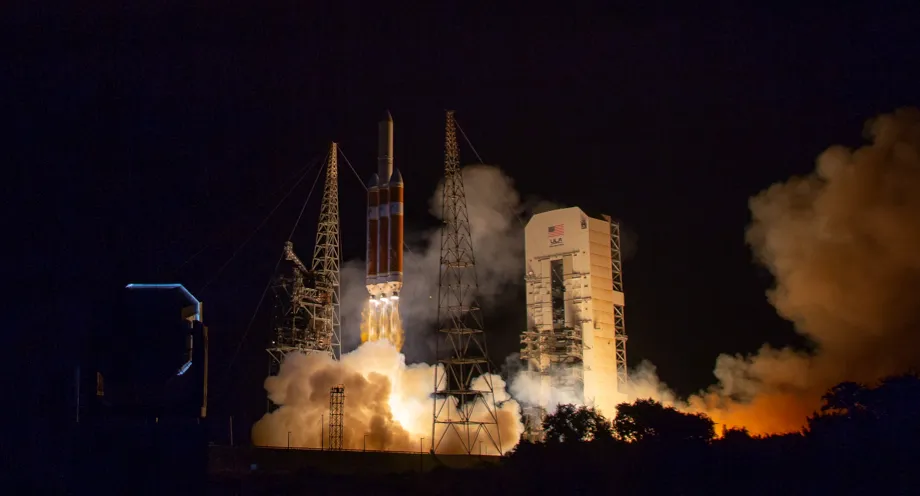Scientists have located the source of high-energy particles originating from the Sun that can be hazardous to air passengers and affect satellites.
These particles shoot from the Sun at high speed during storms in its outer atmosphere.
If they manage to reach Earth, they could disrupt satellites and electronic infrastructure, as well as posing a possible radiation risk to astronauts and people travelling in planes.
In 1859, a large solar storm called the Carrington Event caused widespread issues with telegraph systems across Europe and the United States.
Given our reliance on electricity today, a repeat storm of such magnitude could be far more devastating.
Read more about the Sun:
- Most detailed sunspot image to date captured by new solar telescope
- Solar Orbiter: 'Campfires' captured in closest-ever images of Sun
Researchers at University College London (UCL) and George Mason University in the US believe they have located where on the Sun these particles come from, in a bid to better predict when they might strike again.
Their findings, published in Science Advances journal, indicate that the particles have the same “fingerprint” as plasma located low in the Sun’s corona, close to the middle region of the Sun’s atmosphere.
“In our study we have observed for the first time exactly where solar energetic particles come from on the Sun,” said co-author Dr Stephanie Yardley, from UCL.
“Our evidence supports theories that these highly charged particles originate from plasma that has been held down low in the Sun’s atmosphere by strong magnetic fields.
“These energetic particles, once released, are then accelerated by eruptions that travel at a speed of a few thousand kilometres a second. Energetic particles can arrive at Earth very quickly, within several minutes to a few hours, with these events lasting for days.
“Currently, we can only provide forecasts of these events as they are taking place, as it is highly challenging to predict these events before they occur.
“By understanding the Sun’s processes better we can improve forecasts so that, when a major solar storm hits, we have time to act to reduce risks.”

Researchers made the discovery using measurements from NASA’s Wind satellite, located between the Sun and Earth.
They looked at a number of solar energetic particle streams, each lasting at least a day, in January 2014. These particles came from a region of the Sun known as 11944, which had an extremely strong magnetic field.
Solar flares and coronal mass ejections were frequently observed and it was one of the largest active regions on the Sun at the time. The region was even visible from Earth, seen as a dark sunspot on the Sun's surface.
“Our observations provide a tantalising glimpse into where the material that produces solar energetic particles comes from in a few events from the last solar cycle," said lead author Dr David Brooks, from George Mason University.
“We are now starting a new solar cycle, and once it gets going we will use the same techniques to see if our results are generally true, or if these events are somehow unusual.
“We are lucky in that our understanding of the mechanisms behind solar storms and solar energetic particles is likely to advance quickly over coming years thanks to data that will be gained from two spacecraft – ESA’s Solar Orbiter and the NASA Parker Solar Probe – that are heading closer to the Sun than any spacecraft has been before.”
Could a solar storm take down the internet?
Billions of tonnes of magnetised plasma are periodically ejected into space by the Sun’s churning convection currents in the upper layers of its atmosphere. These ‘coronal mass ejections’ (CMEs) travel at speeds of up to 11,000,000 kilometres per hour, and the Sun can fire off as many as 20 per week, depending on where it is in its 11-year activity cycle.
Although CMEs are common, they are launched in a narrow arc, and the chances of a large one hitting the Earth are relatively low. We had a near miss in 2012, but the last big strike was in 1859, before society became reliant on electricity.
If a CME on a similar scale was to strike the Earth today, it could damage the electronics in orbiting satellites, disrupting navigation and communications systems, as well as the GPS time synchronisation that the internet relies on to function. It would also create a surge of electromagnetic radiation in the atmosphere, causing huge currents in our power grids which could burn out electrical transformers, leading to length outages.
Without power, society itself would grind to a halt – not just the internet. But this is a worst-case scenario. Scientists monitoring the Sun would be able to give us a couple of days’ warning of a dangerous CME, and in that time, vulnerable satellites could be shut down temporarily, and power grids reconfigured, in order to limit the disruption.
Read more:
